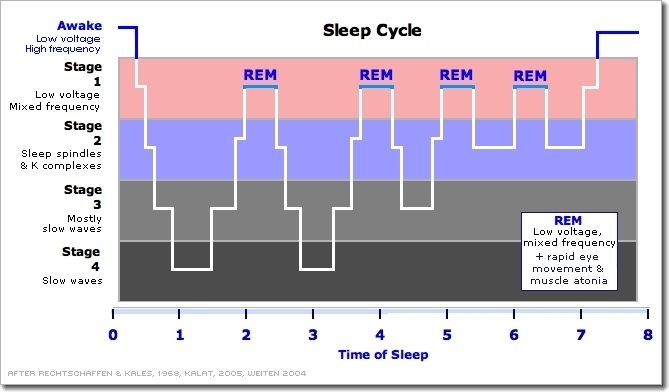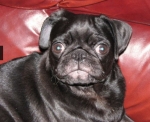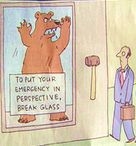Identifying REM
- Gryffandor
- Posts: 20
- Joined: Sat Feb 22, 2014 8:31 pm
- Location: Texas
Identifying REM
I'm interested in identifying periods of REM. Using Sleepyhead or ResScan which graph do I look at & what pattern should I see? At my last visit with sleep doc he was having problems identifying REM periods. He indicated the patterns he identified as REM sleep lasted too long. He found 2 periods but they each lasted over an hour (way too long for normal REM periods).
Thanks for any advice.
Thanks for any advice.
Re: Identifying REM
These machines don't really gather any sleep stage details that are easily identifiable.
So there's nothing on the machine's software to help you. Heck, the machine can't even tell if you are awake or asleep.
Some people think they can identify sleep stages by breathing (flow rate) patterns but that's real iffy and more of a guess than anything. I have looked and looked and I can't find any pattern that shows it clearly and I have a pretty good idea when my REM occurs and I can't tell enough of a difference to know for sure.
If you did have a lot of REM during the sleep study... more than normal...you may be experiencing "REM rebound"...google it and you will see what I mean.
So there's nothing on the machine's software to help you. Heck, the machine can't even tell if you are awake or asleep.
Some people think they can identify sleep stages by breathing (flow rate) patterns but that's real iffy and more of a guess than anything. I have looked and looked and I can't find any pattern that shows it clearly and I have a pretty good idea when my REM occurs and I can't tell enough of a difference to know for sure.
If you did have a lot of REM during the sleep study... more than normal...you may be experiencing "REM rebound"...google it and you will see what I mean.
_________________
| Machine: AirCurve™ 10 VAuto BiLevel Machine with HumidAir™ Heated Humidifier |
| Additional Comments: Mask Bleep Eclipse https://bleepsleep.com/the-eclipse/ |
I may have to RISE but I refuse to SHINE.
Re: Identifying REM
As I understand it, you can't check for REM sleep in ResScan or SleepyHead.
http://www.webmd.com/sleep-disorders/di ... r-disorder
http://www.webmd.com/sleep-disorders/di ... r-disorder
_________________
| Humidifier: S9™ Series H5i™ Heated Humidifier with Climate Control |
| Additional Comments: S9 Autoset machine; Ruby chinstrap under the mask straps; ResScan 5.6 |
see my recent set-up and Statistics:
http://i.imgur.com/TewT8G9.png
see my recent ResScan treatment results:
http://i.imgur.com/3oia0EY.png
http://i.imgur.com/QEjvlVY.png
http://i.imgur.com/TewT8G9.png
see my recent ResScan treatment results:
http://i.imgur.com/3oia0EY.png
http://i.imgur.com/QEjvlVY.png
- Gryffandor
- Posts: 20
- Joined: Sat Feb 22, 2014 8:31 pm
- Location: Texas
Re: Identifying REM
Thanks Pugsy for your insight. You are a never ending source of great information.
Thanks to avi123 as well.
Thanks to avi123 as well.
- chunkyfrog
- Posts: 34545
- Joined: Mon Jul 12, 2010 5:10 pm
- Location: Nowhere special--this year in particular.
Re: Identifying REM
Some of the sensors used during a lab PSG detect rapid eye movement, which is usually associated with REM sleep.
_________________
| Mask: AirFit™ P10 For Her Nasal Pillow CPAP Mask with Headgear |
| Additional Comments: Airsense 10 Autoset for Her |
- The Latinist
- Posts: 465
- Joined: Sat Apr 19, 2014 10:00 pm
Re: Identifying REM
I definitely had this. 53% REM during the titration phase and the most dreams I'd had in years. Mentioned it to the tech, who said "I'm not supposed to talk about the test ... but look up REM rebound."Pugsy wrote:If you did have a lot of REM during the sleep study... more than normal...you may be experiencing "REM rebound"...google it and you will see what I mean.
_________________
| Mask: AirFit™ P10 Nasal Pillow CPAP Mask with Headgear |
| Humidifier: S9™ Series H5i™ Heated Humidifier with Climate Control |
| Additional Comments: APAP 12-16 cmH2O, EPR 1. Untreated AHI: 96; treated AHI 2.3. |
Re: Identifying REM
There's no direct way to detect REM with a CPAP machine.
However, if you have periods of problem breathing during the night, and they sort of look like REM patterns, you might draw the inference that they are REM periods. Especially if you're a good doctor/technician familiar with what REM breathing patterns look like. Especially if the patient is known to have REM problems from a sleep test.
Even then, it's probably a bit of a guess. However, it may not make a difference whether it's 100% correct or not if the suspicion of REM helps you adjust the therapy to where it works better. Sometimes you make educated guesses and they lead you to a solution.
However, if you have periods of problem breathing during the night, and they sort of look like REM patterns, you might draw the inference that they are REM periods. Especially if you're a good doctor/technician familiar with what REM breathing patterns look like. Especially if the patient is known to have REM problems from a sleep test.
Even then, it's probably a bit of a guess. However, it may not make a difference whether it's 100% correct or not if the suspicion of REM helps you adjust the therapy to where it works better. Sometimes you make educated guesses and they lead you to a solution.
_________________
| Mask: Swift™ FX Nasal Pillow CPAP Mask with Headgear |
| Humidifier: S9™ Series H5i™ Heated Humidifier with Climate Control |
| Additional Comments: Also SleepyHead, PRS1 Auto, Respironics Auto M series, Legacy Auto, and Legacy Plus |
Please enter your equipment in your profile so we can help you.
Click here for information on the most common alternative to CPAP.
If it's midnight and a DME tells you it's dark outside, go and check for yourself.
Useful Links.
Click here for information on the most common alternative to CPAP.
If it's midnight and a DME tells you it's dark outside, go and check for yourself.
Useful Links.
Re: Identifying REM
I believe for some people the breathing rates can identify the REM cycles. Here's a thread I started a while back.Gryffandor wrote:I'm interested in identifying periods of REM. Using Sleepyhead or ResScan which graph do I look at & what pattern should I see? At my last visit with sleep doc he was having problems identifying REM periods. He indicated the patterns he identified as REM sleep lasted too long. He found 2 periods but they each lasted over an hour (way too long for normal REM periods).
Thanks for any advice.
viewtopic.php?f=1&t=94782
Almost every night I have the same pattern of cycles, roughly 100 minutes starting with about an hour of steady breathing followed by 20 minutes of faster, ragged breathing, which I presume is REM. When I have bathroom breaks and/or sleepless periods, they follow the presumed REM; then the cycles repeat. As I've said, this repeats almost every night. BTW, I've found no correlation with apnea events - my AHI averages 1.4, with events scattered pretty randomly through the night. I appreciate that there's no absolute way to prove REM sleep without proper instrumentation, but on the other hand, the lack of a thermometer doesn't mean it isn't cold outside!
From the wiki:
Given these descriptions, when see 60 minutes of "remarkably regular, both in amplitude and frequency" breathing followed by 20 minutes of "Irregular breathing with sudden changes in both amplitude and frequency" three to four times a night, repeating every night for a year, I'm pretty convinced I'm seeing REM sleep.http://en.wikipedia.org/wiki/Sleep_and_breathing wrote:
Steady NREM (Non-REM) sleep
Ventilation
Breathing is remarkably regular, both in amplitude and frequency in steady NREM sleep. Steady NREM sleep has the lowest indices of variability of all sleep stages. Minute ventilation decreases by 13% in steady stage II sleep and by 15% in steady slow wave sleep (Stage III and Stage IV sleep). Mean inspiratory flow is decreased but inspiratory duration and respiratory cycle duration are unchanged, resulting in an overall decreased tidal volume.
...
Steady REM Sleep
Ventilation
Irregular breathing with sudden changes in both amplitude and frequency at times interrupted by central apneas lasting 10-30 seconds are noted in Rapid Eye Movement (REM) sleep. (These are physiologic changes and are different from abnormal breathing patterns noted in sleep disordered breathing). These breathing irregularities are not random, but correspond to bursts of eye movements. This breathing pattern is not controlled by the chemoreceptors, but is due to the activation of behavioral respiratory control system by REM sleep processes. Quantitative measure of airflow is quite variable in this sleep stage and has been shown to be increased, decreased or unchanged. Tidal volume has also been shown to be increased, decreased or unchanged by quantitative measures in REM sleep. So breathing during REM sleep is somewhat discordant.
_________________
| Machine: DreamStation Auto CPAP Machine |
| Mask: Quattro™ Air Full Face Mask with Headgear |
| Humidifier: DreamStation Heated Humidifier |
| Additional Comments: Pressure 9-20, average ~9.5; often use battery power while off-grid |
Hark, how hard he fetches breath . . . Act II, Scene IV, King Henry IV Part I, William Shakespeare
Choosing a Battery thread: http://www.cpaptalk.com/viewtopic/t1140 ... ttery.html
Choosing a Battery thread: http://www.cpaptalk.com/viewtopic/t1140 ... ttery.html
- Sir NoddinOff
- Posts: 4190
- Joined: Mon May 14, 2012 5:30 pm
- Location: California
Re: Identifying REM
Right on CapnLoki. I'm one of the 'other people' Pugsy mentioned. I've been plugging away at this concept for years and have some supporters. Caveat: I realize some people's breathing and tidal volume doesn't change much from being awake to being asleep, however for the many that do show patterns of change (like CapriLoki and me) the instructions below shows what one can do to get an approximation of 'real sleep' and to a lesser degree, REM stages. NOTE: This won't specially tell you your REM stages but you can infer them from the chart I've appended at the bottom. IMO, This method is about the best you can do if you don't have your brain waves analyzed in conjunction with a chest respiration strap:
The method I'll describe below will give you a window into what's happening during the entire night. Typically the first REM period starts 60 to 90 minutes after sleep onset. You will usually see flow spikes and various apneas before, during and maybe after the REM periods. Most people with normal sleep, after several hours, come back up to stage one or two and then go back to REM for another go round with the same apnea and flow spikes, but generally not as pronounced as the first set. The same continues for the rest of the night. Age can be a big factor in one's sleep patterns. This method below works nicely with Sleephead cuz it does time calcs for you automatically, but with some experience it'll work with any other sleep software:
To tell when I'm actually sleeping I look at three lines: My Respiration Rate, plus my Tidal Volume line, plus my Minute Ventilation line, then correlate them to my software's timeline (the hourly horizontal axis at the bottom). Unfortunately, I can't tell you what your ideal lines/graphs are in these three categories because everybody is different, however I can say that when you absolutely know you were asleep inspect those three aforementioned flow lines (RR, TV and MV), memorize the patterns, then overlay that data with your precise known sleep times. I realize this sounds hard to do but it's not really that tough. Over several nights, a strong pattern should emerge if you are careful in your observations. You will also be able to spot transitions from wakefulness to real sleep and vice versa, which is actually the easiest part. This critical inspection process is the key to understanding your body/brain entry into the four recognized sleep stages, and as a bonus it lets you drop from your calculations all the minutes/hours you were awake (Tip: these sleep transition periods all look a lot rougher, choppy even). LOOK FOR THE CORRESPONDING 'REAL SLEEP' PERIODS (time in hours) BY INSPECTING AND NOTING THE TIME LINE AT THE BOTTOM OF EACH OF THE THREE AFOREMENTIONED GRAPHS. This works with Sleepyhead, ResScan and Encore Pro, all of which I use. It's very cool to see it all play out at night, as long as you feel good enough in the morning to enjoy it. Summary: Keep records of the things I mentioned above for a week or so... you will begin to see distinct waveform patterns emerge contrasting wakefulness vs sleep.

The method I'll describe below will give you a window into what's happening during the entire night. Typically the first REM period starts 60 to 90 minutes after sleep onset. You will usually see flow spikes and various apneas before, during and maybe after the REM periods. Most people with normal sleep, after several hours, come back up to stage one or two and then go back to REM for another go round with the same apnea and flow spikes, but generally not as pronounced as the first set. The same continues for the rest of the night. Age can be a big factor in one's sleep patterns. This method below works nicely with Sleephead cuz it does time calcs for you automatically, but with some experience it'll work with any other sleep software:
To tell when I'm actually sleeping I look at three lines: My Respiration Rate, plus my Tidal Volume line, plus my Minute Ventilation line, then correlate them to my software's timeline (the hourly horizontal axis at the bottom). Unfortunately, I can't tell you what your ideal lines/graphs are in these three categories because everybody is different, however I can say that when you absolutely know you were asleep inspect those three aforementioned flow lines (RR, TV and MV), memorize the patterns, then overlay that data with your precise known sleep times. I realize this sounds hard to do but it's not really that tough. Over several nights, a strong pattern should emerge if you are careful in your observations. You will also be able to spot transitions from wakefulness to real sleep and vice versa, which is actually the easiest part. This critical inspection process is the key to understanding your body/brain entry into the four recognized sleep stages, and as a bonus it lets you drop from your calculations all the minutes/hours you were awake (Tip: these sleep transition periods all look a lot rougher, choppy even). LOOK FOR THE CORRESPONDING 'REAL SLEEP' PERIODS (time in hours) BY INSPECTING AND NOTING THE TIME LINE AT THE BOTTOM OF EACH OF THE THREE AFOREMENTIONED GRAPHS. This works with Sleepyhead, ResScan and Encore Pro, all of which I use. It's very cool to see it all play out at night, as long as you feel good enough in the morning to enjoy it. Summary: Keep records of the things I mentioned above for a week or so... you will begin to see distinct waveform patterns emerge contrasting wakefulness vs sleep.

_________________
| Mask: AirFit™ F10 Full Face Mask with Headgear |
| Additional Comments: Sleepyhead software v.0.9.8.1 Open GL and Encore Pro v2.2. |
I like my ResMed AirFit F10 FFM - reasonably low leaks for my ASV therapy. I'm currently using a PR S1 AutoSV 960P Advanced. I also keep a ResMed S9 Adapt as backup. I use a heated Hibernite hose. Still rockin' with Win 7 by using GWX to stop Win 10.
- Gryffandor
- Posts: 20
- Joined: Sat Feb 22, 2014 8:31 pm
- Location: Texas
Re: Identifying REM
A big thank you to CapnLoki & Sir NoddinOff. You certainly present a starting point for me to look into. I didn't expect such a scholarly dissertation. Being retired I have lots of time on my hands to devote to checking your theories. I was hoping for a simpler solution but this will give me a new project to fill some hours. Thanks to all who replied.















